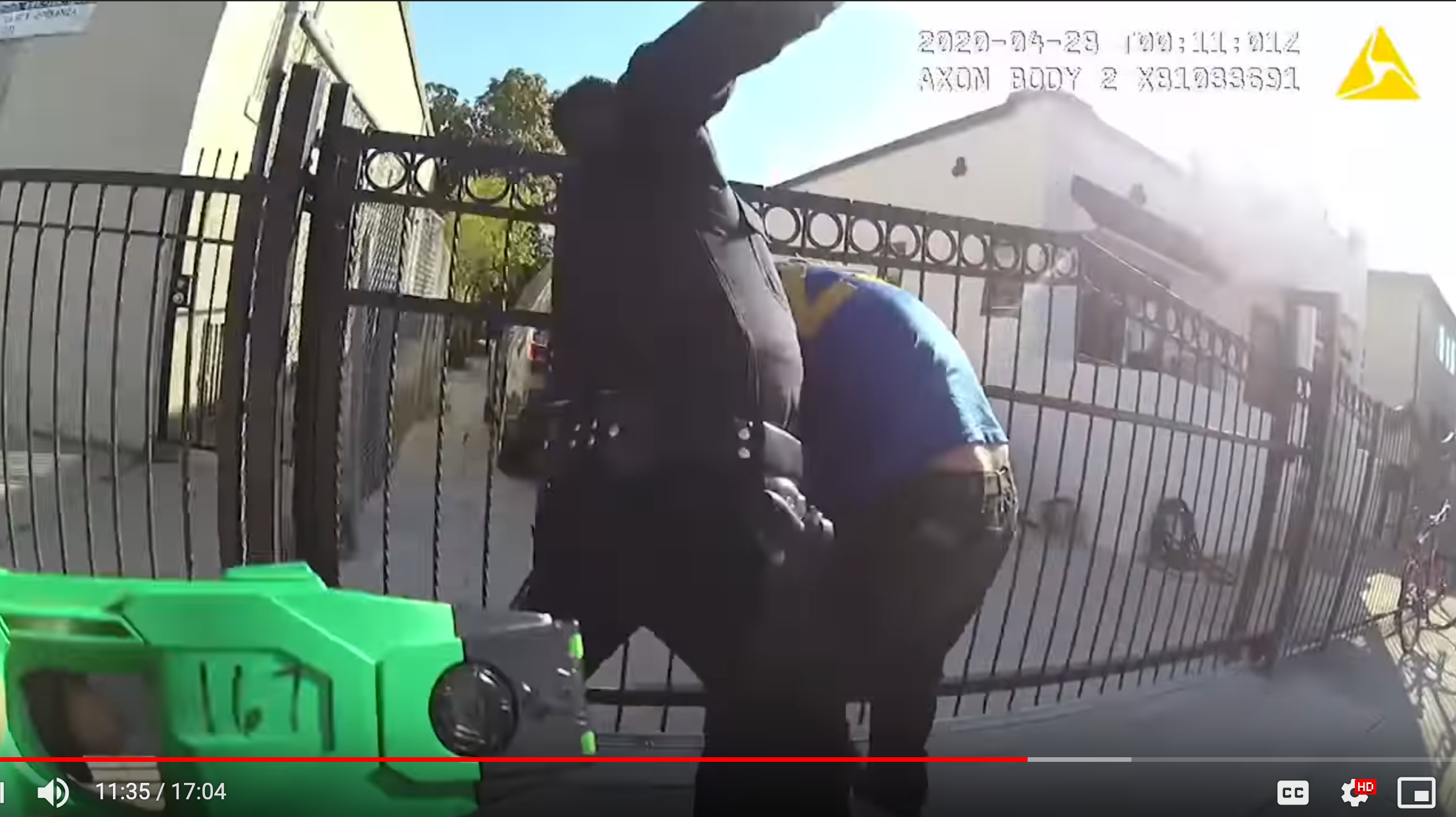Several lifetimes ago in January of this year, LAPD homeless coordinator Commander Donald Graham reported that incidents of use of force against unhoused persons had jumped by 26 percent in the third quarter of 2019. The additional 45 reported cases brought the total for the quarter to 217 - 35 percent of all 615 use-of-force incidents reported department-wide during that same period.
Despite that significant spike, the discussion of those findings at the January 21 Police Commission meeting was relatively brief (below, at start of meeting).
Saying he had read studies indicating that people could experience PTSD within seven days of being on the streets, Graham had argued that the prevalence of mental illness among the unhoused had factored heavily into officers' decisions to resort to force. So had the "increased contacts between [law enforcement] and persons experiencing homelessness" resulting from the growing demand for action about encampments from both the community and elected officials, he said.
The perspective that trauma experienced by the unhoused makes the use of force inevitable is a profoundly dangerous one.
Not only does it point the finger of blame outwards, at a vulnerable population, it absolves LAPD of having to do any reflection on their own role in violent encounters. It also makes Graham's pledge to the commission to continue to raise "awareness" around the need for officers to deploy de-escalation techniques during such encounters an empty one.
With no real discussion around what raising "awareness" meant, what the circumstances were that had led to the deployment of force, to what end force had been used, or even what constituted escalation from the LAPD's perspective, there would be no way to chart patterns or hold LAPD accountable for change. As concerned commission members tried to probe deeper with regard to how the LAPD's philosophy of "enforcement as a last resort" actually translated into practice - e.g. what kind of infrastructure was in place to more consistently move people into services rather than jail cells - Graham's pledge rang emptier still.
Since the May 25 murder of George Floyd by Minneapolis police officers and the subsequent clamor to defund the police, elected officials have finally been more willing to revisit questions of reform, of how and when police are deployed, and of whether resources spent on enforcement might be better directed to services aimed at addressing mental health and the historical inequities that perpetuate generational trauma and factor into houselessness.
Mayor Eric Garcetti’s proposal to redirect ~$150 million from the LAPD’s $3.14 billion budget (and another $100 million from other departments) toward uplifting L.A.’s most disenfranchised populations represented a tentative first step in that direction. The gesture was a reluctant one on his part, coming only after thousands of Angelenos took the streets (and council phone) to demand a reimagining of public safety. And it's a gesture activists continue to decry as more symbolic than substantive; the $133 million in cuts worked out in the budget committee yesterday will shift funds away from weapons, tech, vehicles, new hires, and overtime but not result in any kind of structural change to the department.
L.A. city councilmembers have picked up some of the slack, with Mike Bonin requesting a report back on the emergency calls coming into LAPD to see if they could better be triaged. Then last week, councilmembers Martínez, Herb Wesson, Marqueece Harris-Dawson, Curren Price, and Bob Blumenfield put forward a more transformative motion asking for the development of an emergency response model in collaboration with LAPD and Los Angeles Homeless Services Authority (LAHSA) that would divert nonviolent calls for service to more “appropriate” agencies.
Still, in a statement posted to its website, LAHSA describes itself as being limited by the fact that its outreach teams are not available round the clock.
And the police reforms Garcetti has envisioned, including more de-escalation training and increased disciplinary measures against inappropriate conduct by officers, sound vague in theory and likely mean even less in practice.
No clarity has been offered on how these reforms will deepen the implicit bias training that’s been in place for more than a decade or the additional de-escalation training implemented in 2016. As it is, Garcetti himself has repeatedly touted the number of hours LAPD spends in training when dodging questions about the unprovoked violence officers used against protesters. And there’s been no word on how discipline will be handled in a department that so expertly frames victims as aggressors and avoids accountability as a general rule.
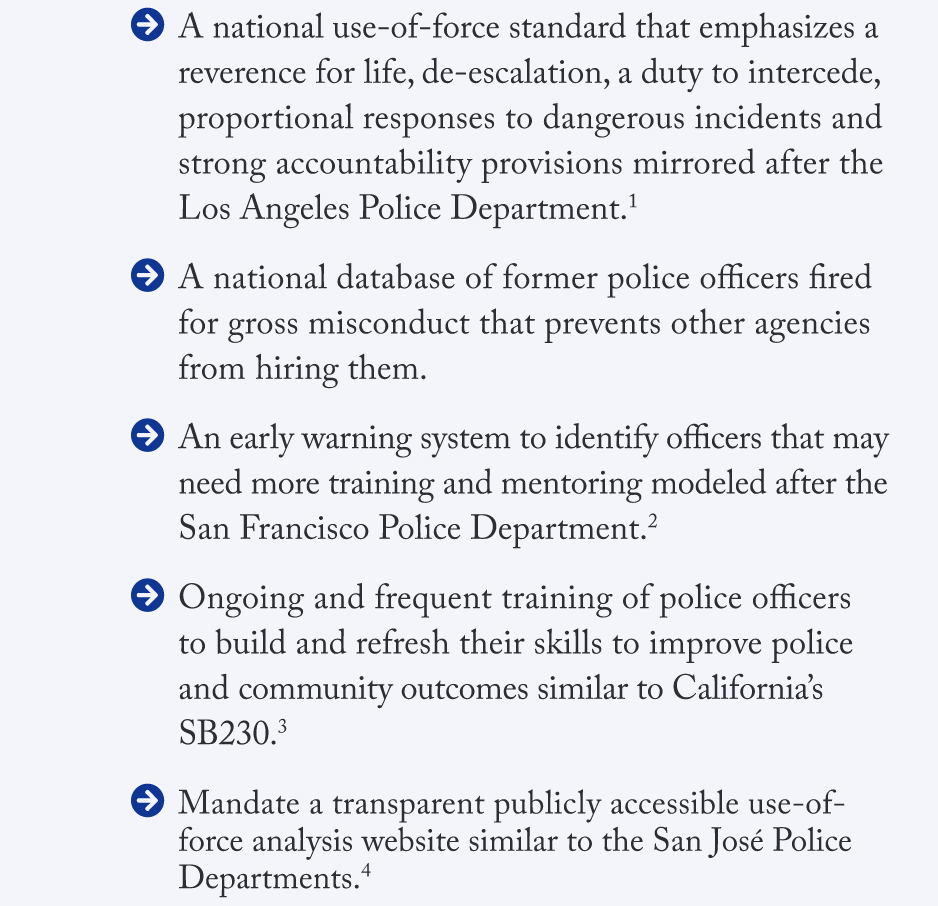
All of which makes it seem like a good moment to unpack how escalation manifests in everyday encounters.
Because it is important to understand that all the de-escalation training in the world is unlikely to impact the way LAPD approaches Black and brown folks, particularly in disenfranchised communities.
De-escalation work tends to be premised on the idea that the other party is the aggressor and the officer is the one reacting to and defusing a situation.
Meanwhile, according to the hundreds of people I've interviewed over the years, engagements I've witnessed firsthand, and even my own experience being stopped by the Sheriffs, officers often begin even the lowest-stakes interactions with the kind of antagonism that immediately escalates the engagement. Unnecessarily raising the stakes, in turn, increases the likelihood the person being engaged will be hit with a punitive citation, arrested for resisting arrest, or subjected to a use of force.
Thus, what follows below is a deconstruction of the body cam footage of veteran LAPD officer Frank Hernández' assault on Richard Castillo, an unhoused, unarmed Boyle Heights resident.
While not all interactions end in the kind of egregious physical violence this one did, the case is instructive for how run-of-the-mill antagonism and escalation pave the way for such abuses of power. The footage also offers an example of how officers leverage the escalation they themselves are responsible for to justify their use of force. Finally, the LAPD’s explicit effort to paint Castillo as an aggressor raises questions about how prepared - or willing - it is to commit to deeper structural change.
_______
Criminalizing houselessness
On April 27, a bystander caught LAPD officer Frank Hernández assaulting Richard Castillo, an unhoused, unarmed Boyle Heights man on tape.
The video, which quickly went viral, captured the worst of the encounter in horrific detail.
In it, Hernández is seen raining nearly 20 blows down on a compliant and cowering Castillo, spitting on him (a potential deadly act during a global pandemic), and then claiming Castillo had attacked him.

Two weeks later, on May 12, the LAPD released a critical incident video in response to the outcry over the assault on Castillo.
In his introduction to the video - which also includes the original call for service, both officers' body cam footage, and the bystander video - LAPD Chief Michel Moore reminded viewers that the bystander video "does not tell the whole story."
It's a plea that seems to imply Hernández will come off a little better once the public sees what led up to the assault.
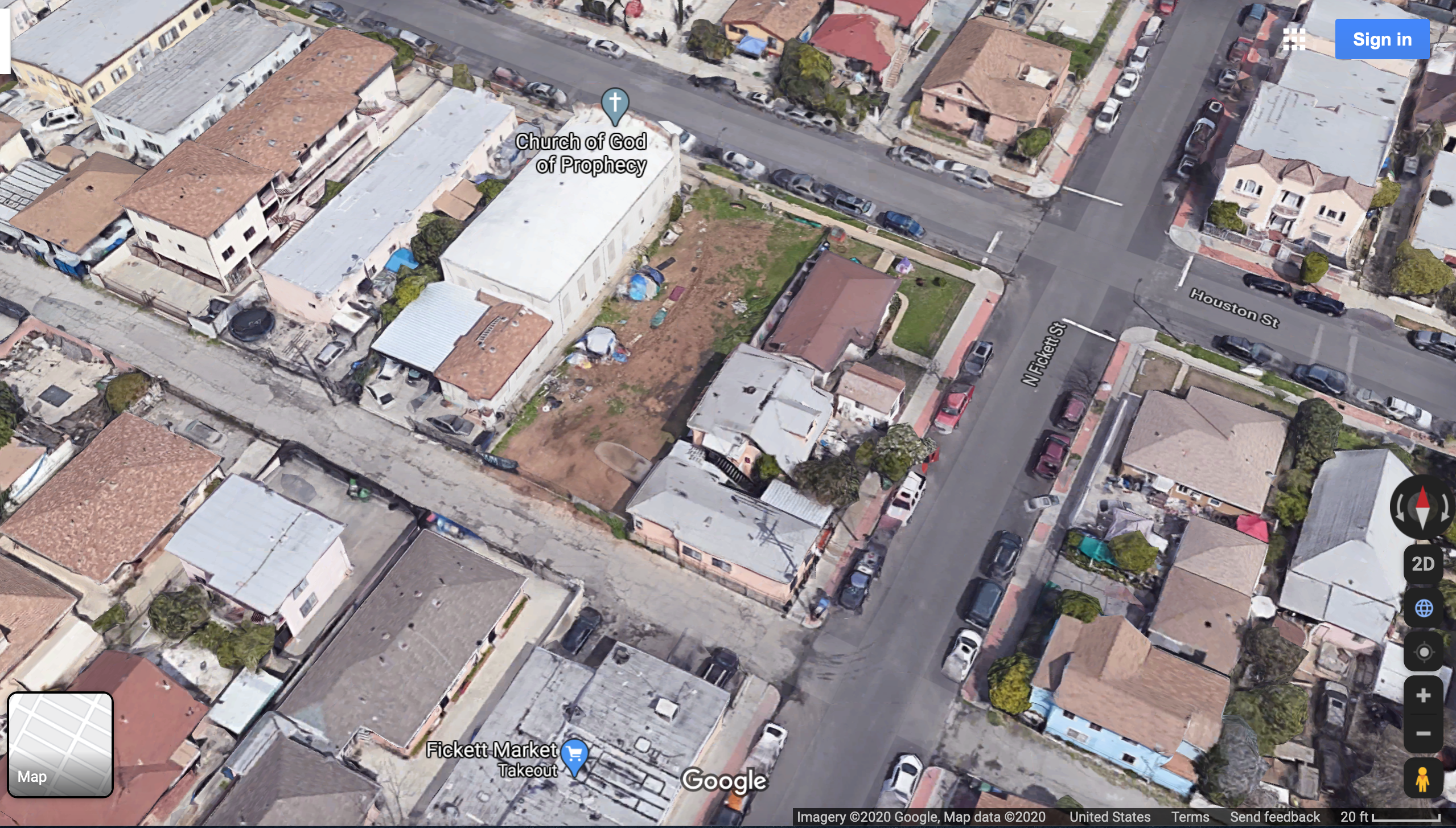
It certainly is true that the call for service - heard at the beginning of the video - shows dispatch put Hernández in a difficult position. He and his partner were essentially tasked with treating the eviction of an unhoused person who had been at a vacant lot for some time, and whom police had apparently evicted previously, as an issue of criminal trespass.
The decision to send two officers - rather than a housing and/or mental health outreach team - was a form of escalation in and of itself. Especially in light of the owner's comments that the man had been hostile to being evicted in the past (assuming the owner to be truthful). And especially now, given the city's formal acknowledgement of the need to allow Angelenos, including the unhoused, to shelter in place during the pandemic emergency.
But rather than depict a volatile unhoused person endangering the safety of an officer - the kind of scenario that Graham had implied was the norm and that Hernández has since tried to claim was the case - the body cam footage instead presents viewers with a volatile officer who, from the very first words spoken to Castillo, deliberately chose escalation at every possible turn.
_______
Escalation begins with hello
You can hear the tension from the outset of the exchange, starting at around 8:59 in the LAPD video.
The officers wasted no time in moving Castillo along, announcing that he was being evicted from his encampment as soon as they made verbal contact with him.
While still some distance from Castillo, Hernández calls out, "What's up man? You gotta go brother, you can't live here...Private property; let's go." [Note: Castillo's dialogue is in white, both officers' is in yellow.]
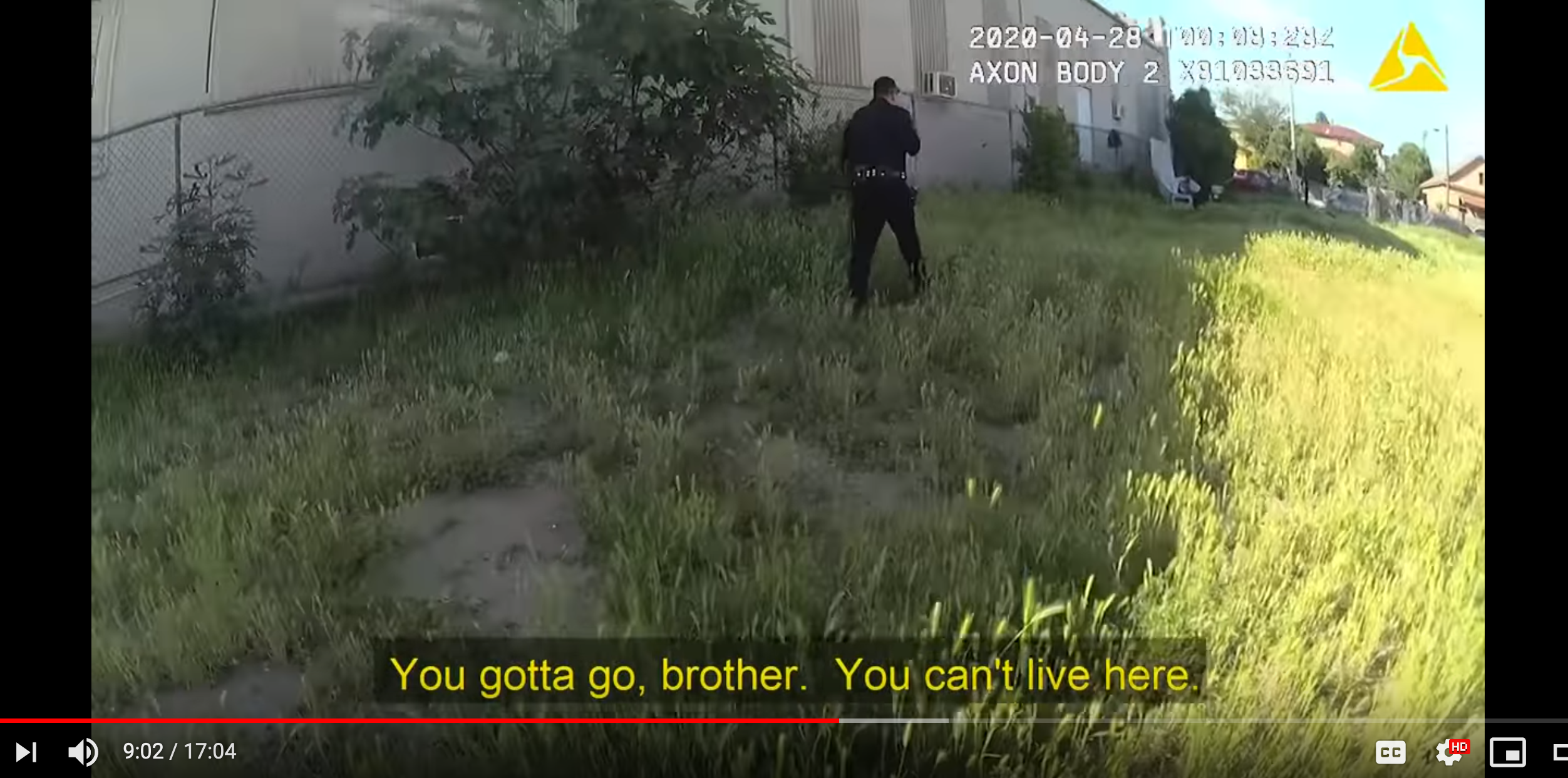
Castillo, unsettled and on the defensive, says he feels like he was snuck up on.
He is reluctant to go, but clearly wants no trouble. He makes that evident by immediately grabbing his bike and moving to exit the lot. He then insults Hernández and says things will go differently next time if the cop sneaks up on him like a gang-banger again, but continues to retreat.
Having achieved his primary goal, Hernández chooses to further escalate the situation, goading Castillo to prevent him from returning. When Castillo says the officer doesn't scare him, Hernández raises his voice and retorts, "You don't scare me!," throws Castillo's rake on the ground, and tells him not to come back or he'll go to jail for trespassing next time.
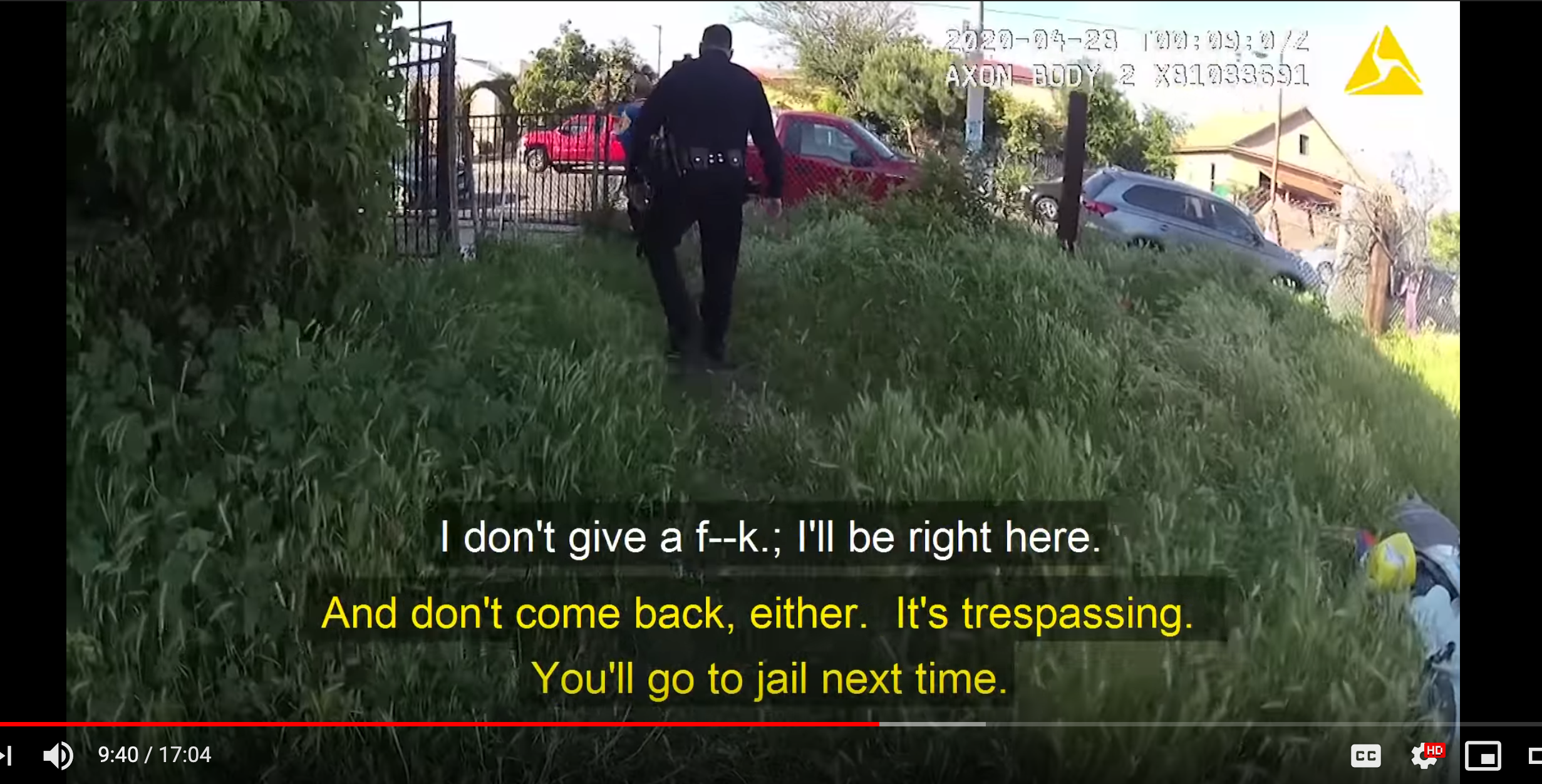
"I'm not gonna argue with you; I'm just gonna let you be [and] go," says Castillo as he moves off the lot and heads up the street.
Hernández' partner catches up to him on the sidewalk. The two watch Castillo walk away. Both are clearly pleased.
Hernández' partner chuckles. "They talk big sh*t until they get in the handcuffs," she says.
Castillo gets halfway up the block and then turns around, seemingly unsure what to do next.
They try to shoo him on.
"I live around here," he says.
"You don't live here anymore. Bye," snarks Hernández.
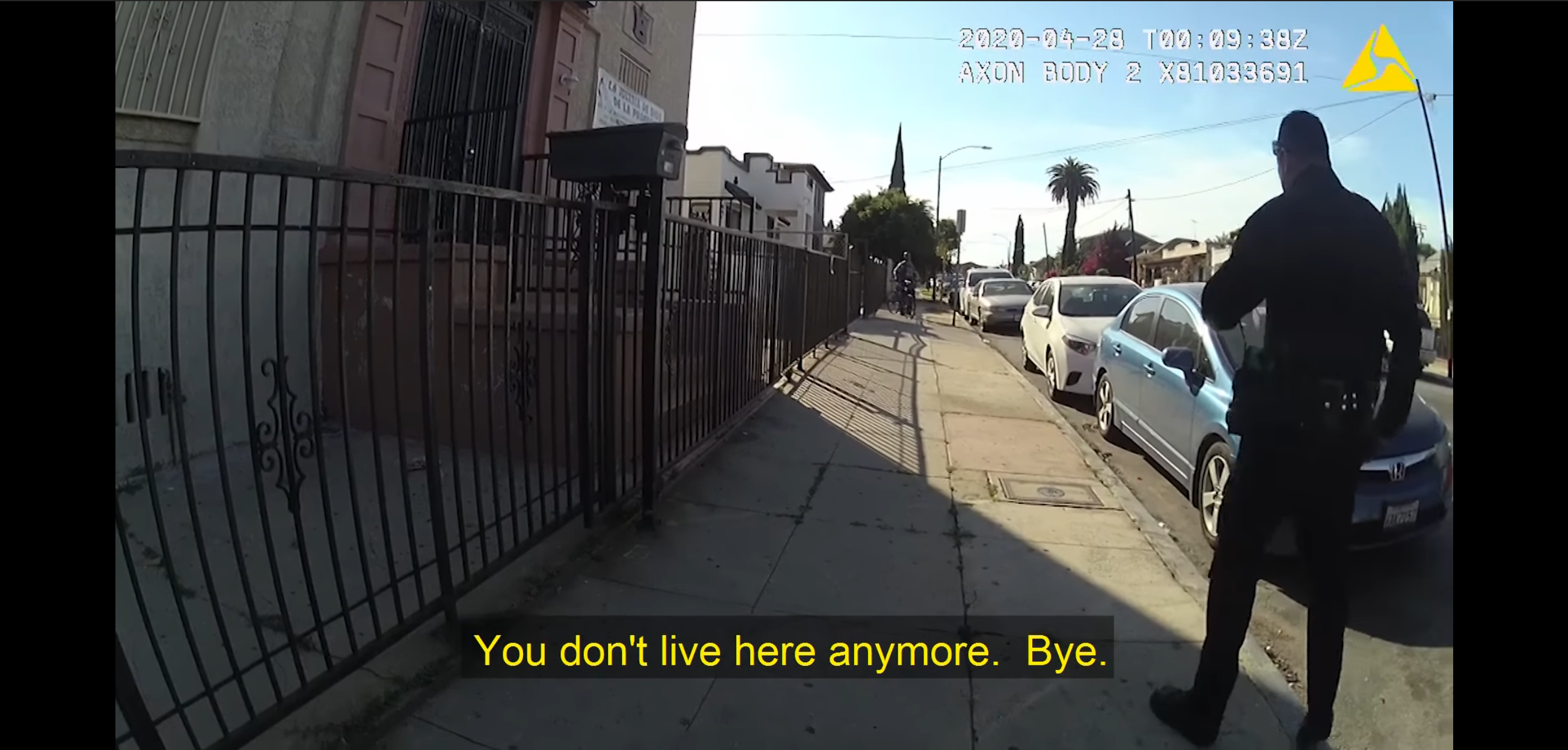
Castillo, who grew up just a couple houses down from the lot and is well-known in the neighborhood, doesn't like being told he has no place there.
"You wanna bet?" Castillo asks, leaning his bike up against the fence.
It's a challenge. But not a physical one.
Castillo clearly feels disrespected. Not just by being unceremoniously swept off a street he came up on, but also by having his word and his identity questioned in this way.
In making this “bet,” he is practically handing Hernández an opportunity to defuse the situation by hearing him out.
Hernández, in contrast, appears to have taken it as a personal challenge to his power and authority.
He chooses escalation yet again. "I wanna bet, yeah," he calls back before whipping out his baton and striding purposefully towards Castillo.
_______
A detainee attempts de-escalation, gets punched in the face
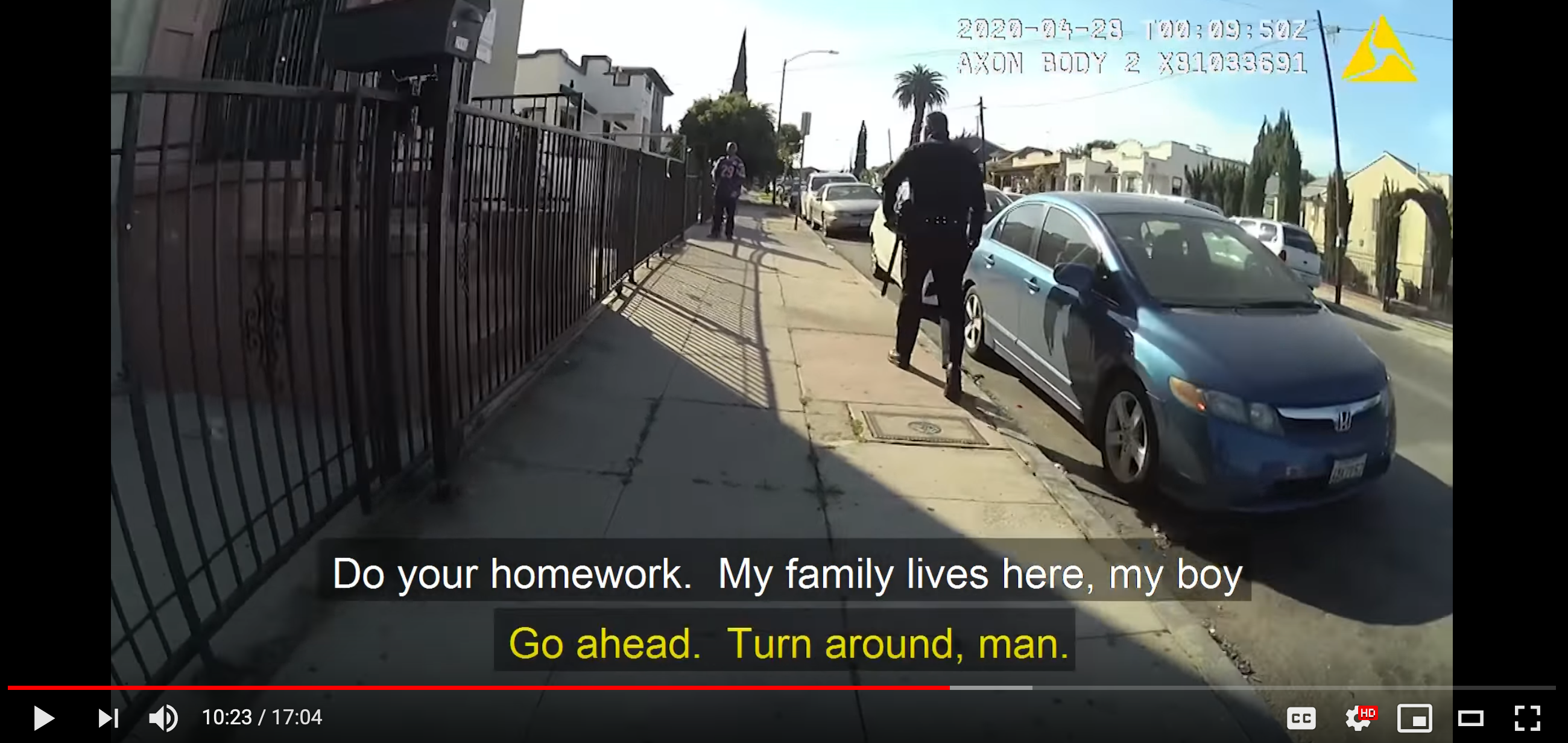
As Castillo ambles back toward the officers, explaining that his family lives there, Hernández raises his voice and tells Castillo to turn around and put his hands out.
Castillo, now slightly more agitated but still calm and moving slowly, watches Hernández bring his baton up to his chest and asks what the officer is planning to do with it.
Hernández won't engage and instead keeps telling him to turn around. But Castillo has already turned and is facing the fence.
Like a lot of men who grew up overpoliced in L.A., he knows which way to face, where to keep his hands, and how far apart to spread his feet. That Hernández keeps barking orders at him when he is already being compliant frustrates Castillo. He recognizes that he’s being messed with.
He's still trying to explain he has a place there but Hernández won't hear it.
Hernández again barks at Castillo to turn around and put his hands behind his back, but Castillo is still moving to obey the first set of orders to put his hands out.
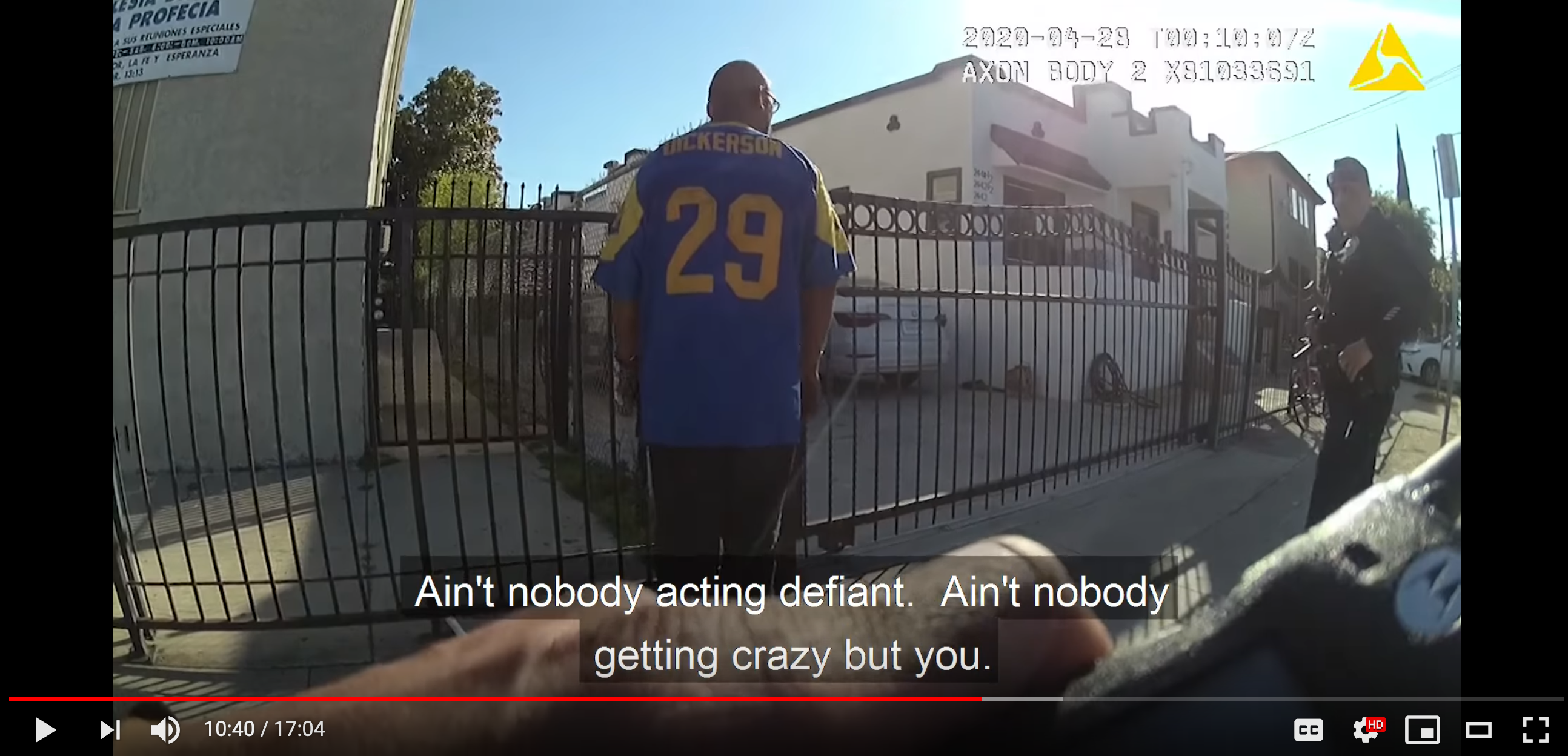
As Castillo places his hands on the fence, Hernández quickly puts his baton away and launches himself at Castillo, grabs him, and appears to try to wrestle him.
His partner - who has wordlessly watched Hernández escalate this situation - now wordlessly grabs at Castillo's wrist. At no time does either of them make the friendly request to conduct a consensual search Hernández' lawyer claims was made.
It all takes Castillo by surprise; he shakes off their hands and asks what the f*ck the officers are trying to do.
Though he and Hernández continue to insult each other, Castillo essentially says he'll be compliant if they stop pushing up on him.
Hernández' partner, in turn, readies her taser (in green).
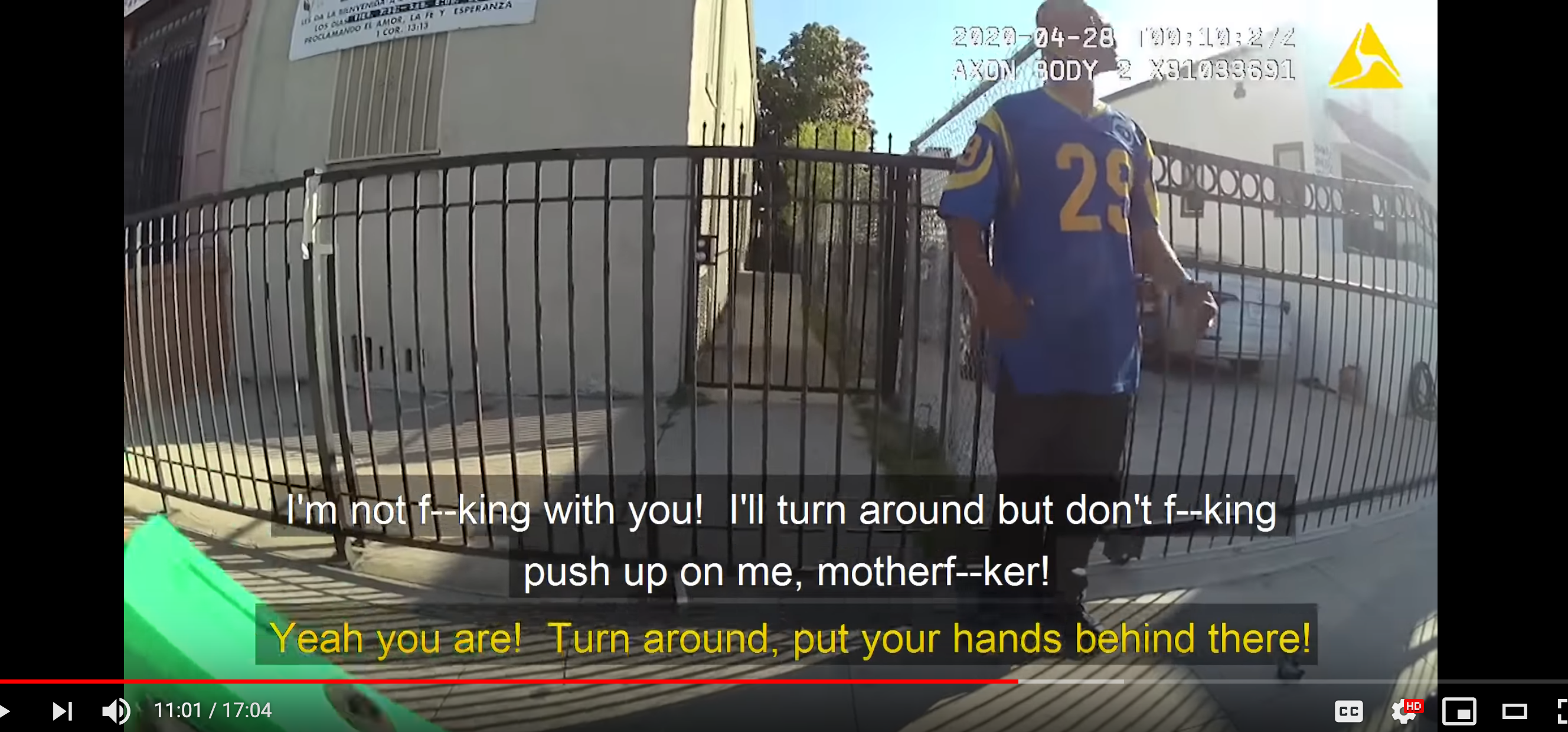
Both officers then tell him to turn around, now threatening to tase him if he does not comply with the command he just told them he was willing to comply with.
[For reasons unknown, LAPD saw fit to diligently censor one set of f-bombs, but not the actual homophobic slur Castillo repeatedly uses.]
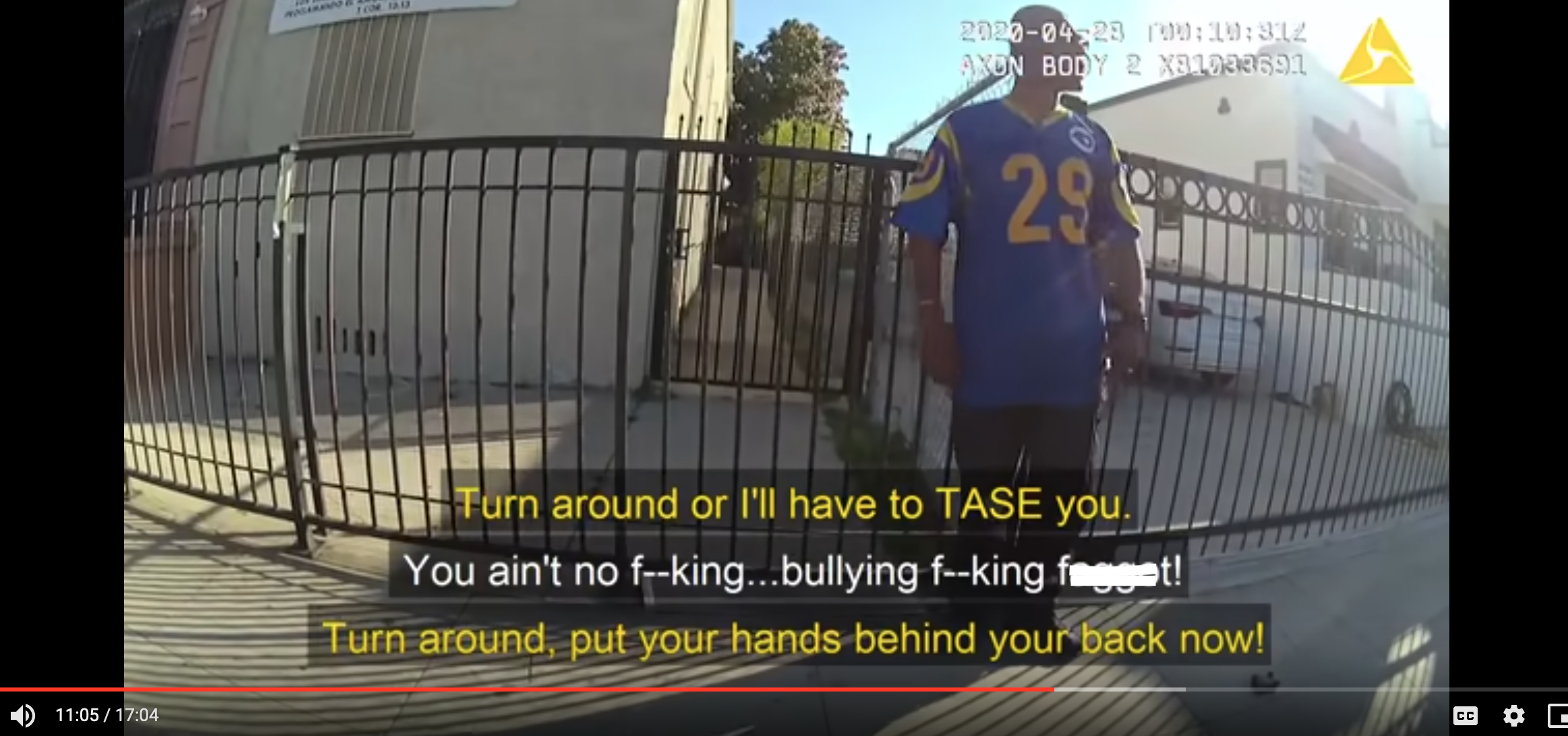
Castillo then turns around and puts his hands behind his back. Hernández grabs his wrists and commands Castillo to spread his feet, even though they are already spread (as is more visible in the bystander video - minute 13:54 in the LAPD video).
He tells Castillo not to fight. Castillo denies he is fighting, and does not appear to be physically resistant, though he continues to vocalize his frustration with the way he is being treated.
Hernández insists that Castillo is indeed fighting him.
Suddenly Hernández yells, "F*ck you, bitch!" and begins pounding on Castillo's back and stomach. He lands somewhere around 20 punches while grunting heavily, shoving Castillo around, and calling him a motherf*cker.
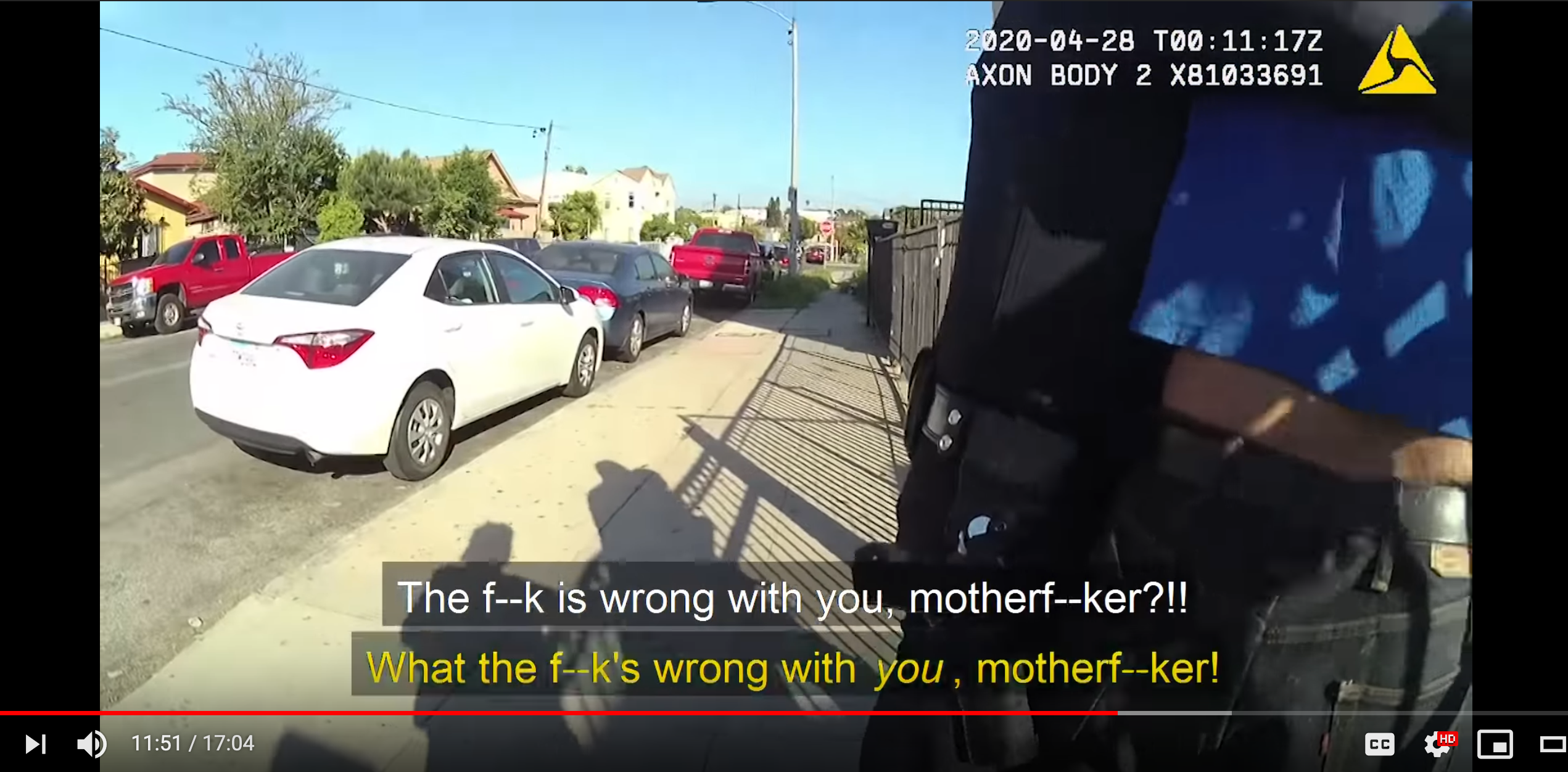
Castillo immediately bends over and moves to protect his head from the blows. He repeatedly tells Hernández to calm down and quit hitting him, asking at one point, "The f*ck is wrong with you, dawg?"
A bystander is heard respectfully interjecting to tell Hernández that what he's doing is not right.
Hernández' partner makes no such interjection.
Instead, she calls for back-up, and only after Hernández stops to catch his breath does she appear to try to de-escalate things by repeating, "Frank" (Hernández' first name).
Then, while Castillo is still wrapped in a nonconsensual bear hug and pushed up against the fence, she asks Castillo to put his hands behind his back.
Hernández, still holding onto Castillo, accuses him of not cooperating. He warns Castillo he is going to get hit again if he doesn't get on the ground. Then Hernández winds up to take another swing at him.
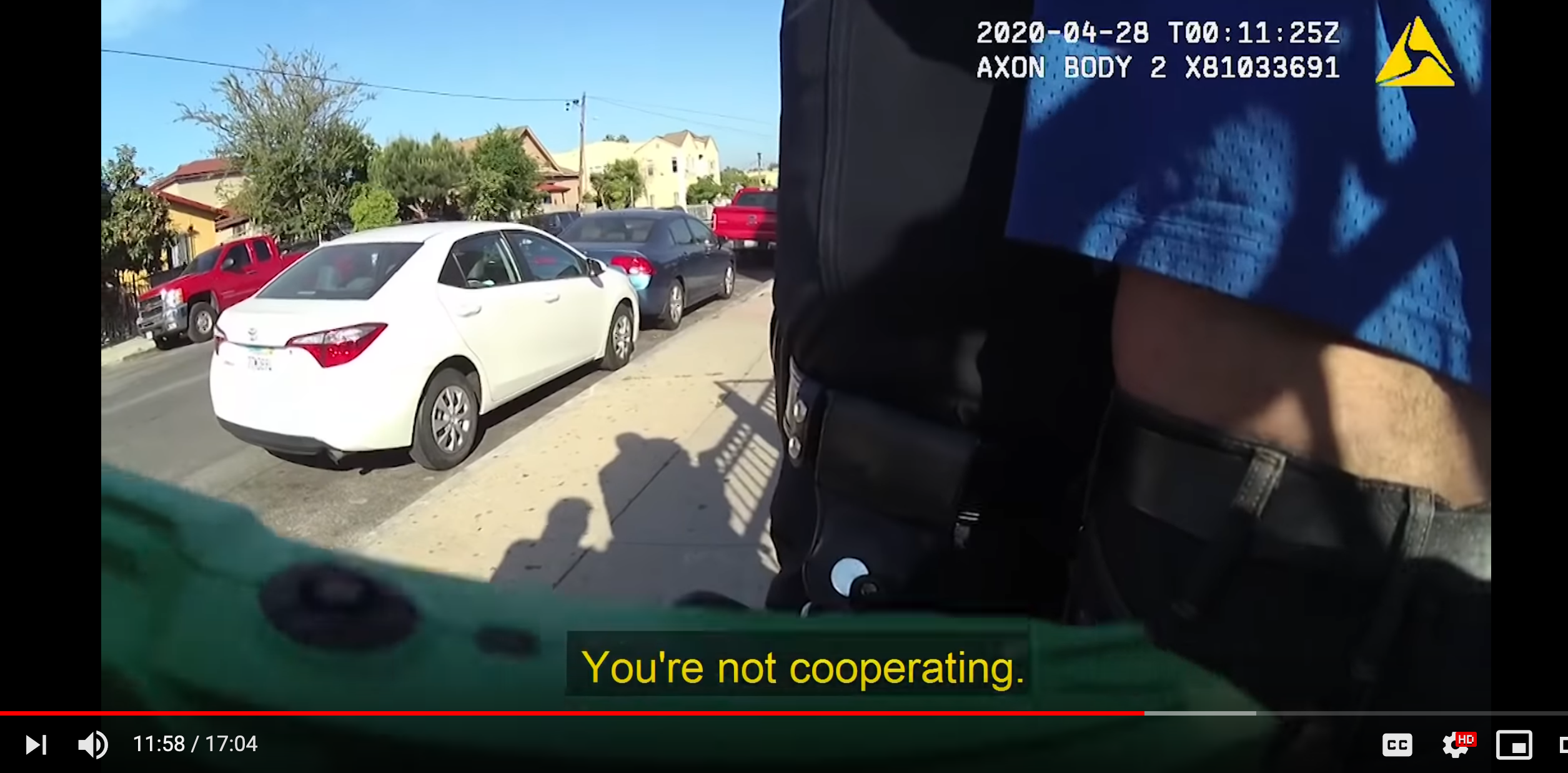
Hernández' partner continues to wave the taser.
Hernández, still out of breath and sounding annoyed, tells his partner to just go ahead and tase Castillo, who protests again that he has done nothing.
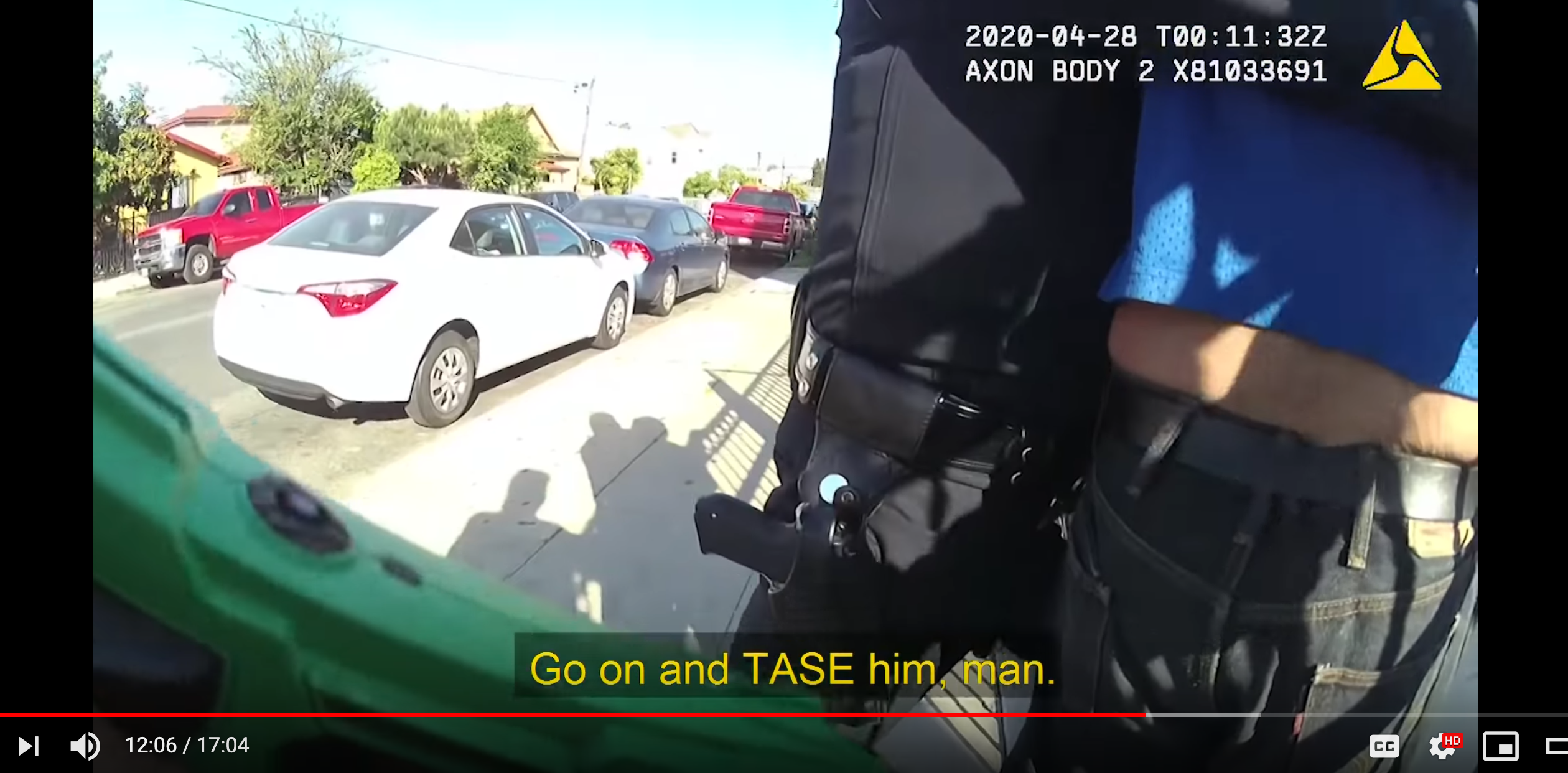
_______
Covering his tracks
Finally, sirens begin wailing in the background.
Castillo, still reeling from being pummeled, asks why he was hit, what is wrong with Hernández, and finally, "Who are you, dawg?"
He is told to shut the f*ck up.
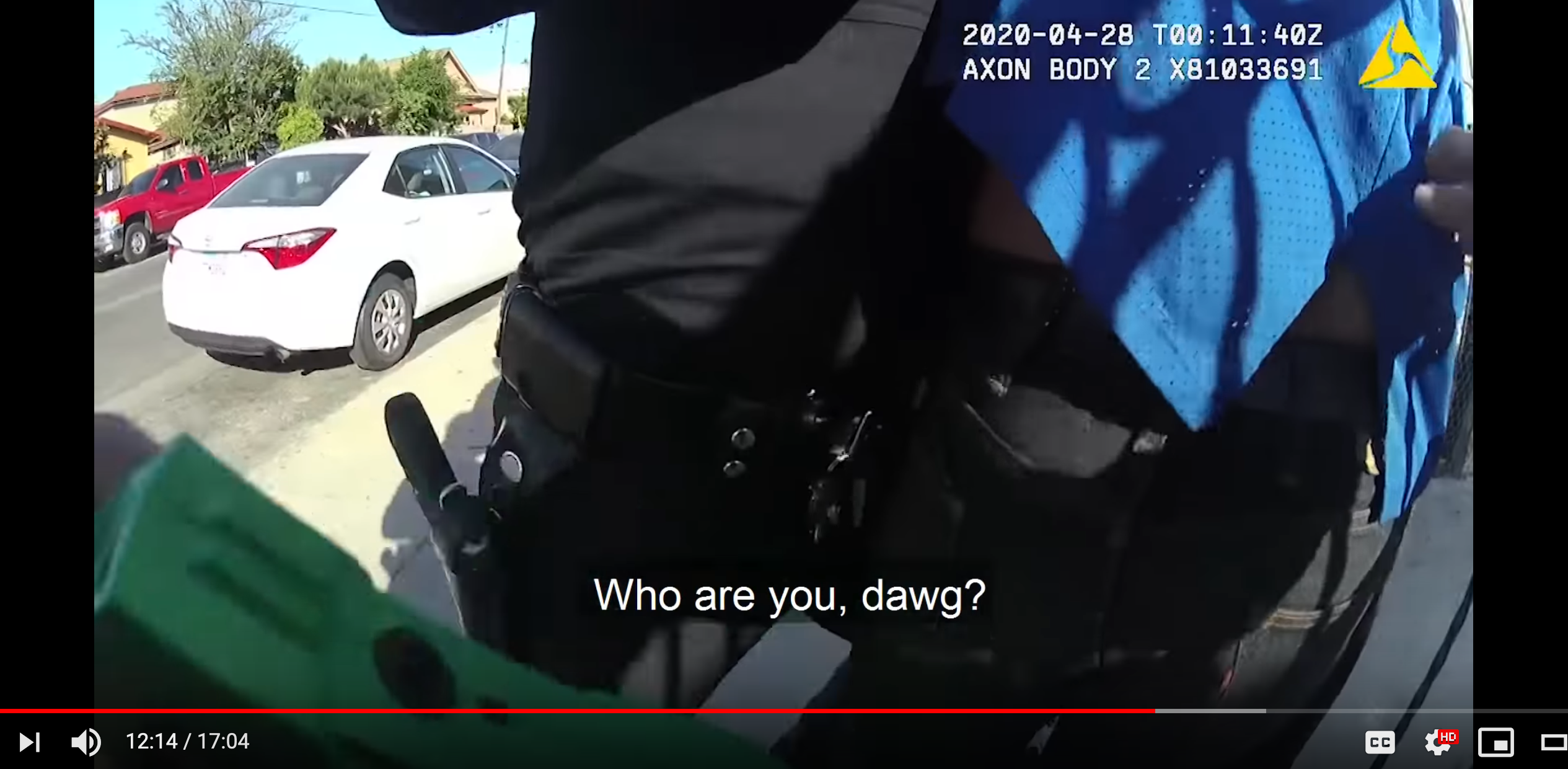
The officers that arrive on the scene move in quickly.
Hernández moves just as nimbly to explain away what he has done.
For the first time, he answers one of Castillo's questions, announcing he hit him because it was Castillo who had grabbed his hand.

Castillo denies this, but he also seems to know the stakes: he could be subjected to more abuse if he appeared to be noncompliant, especially given the complicity of Hernández' partner.
He decides to say nothing.
Hernández, however, has to cover his tracks. He continues to allege Castillo grabbed his hand. Castillo continues to deny it.
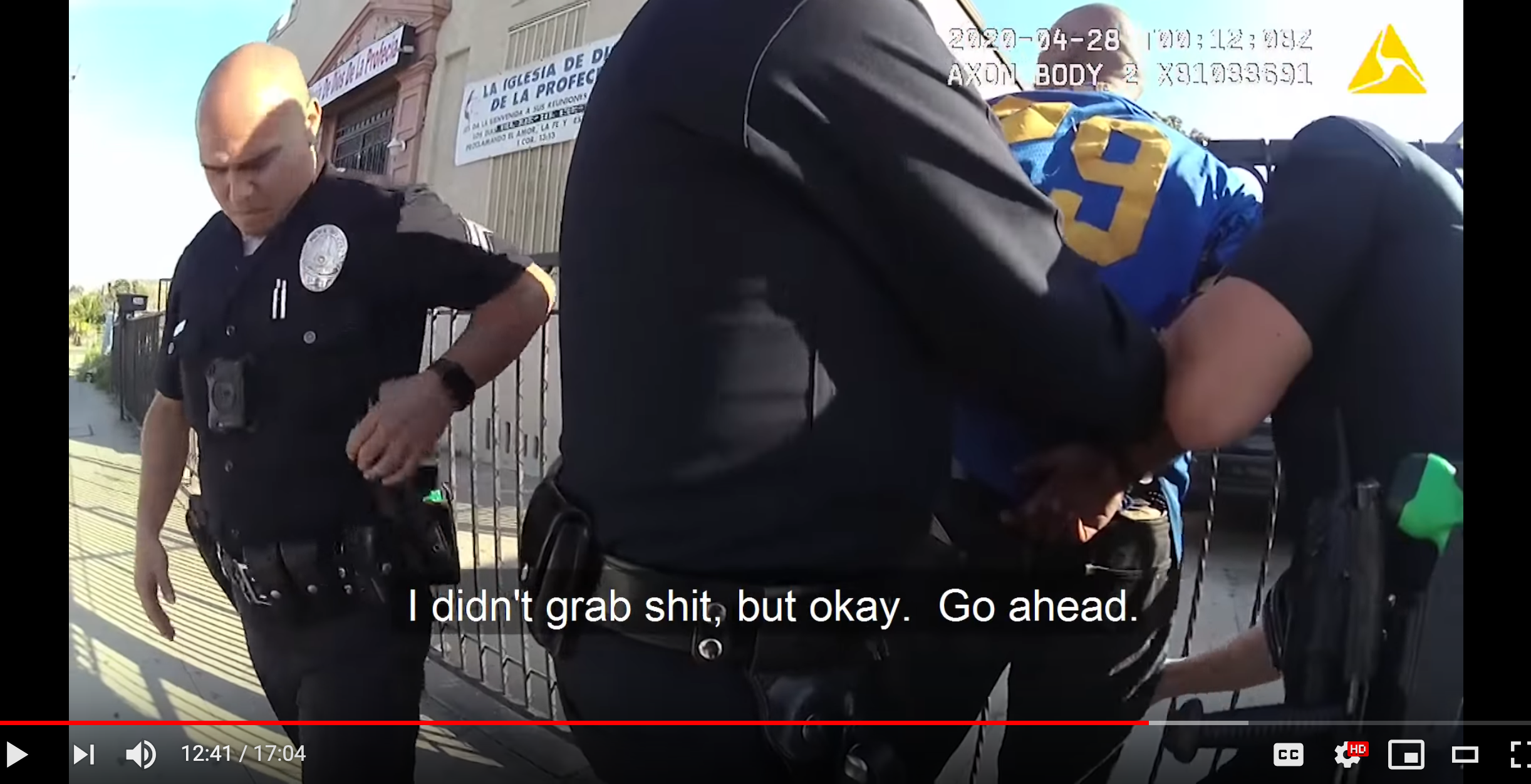
Desperate, Hernández demands to know how his finger got injured. Without hesitation, Castillo acknowledges he bit it.
Of course, if there was indeed a bite, it was something that would have happened during the beating - likely in an effort by Castillo to stop the blows from raining down on his head. It could in no way be construed as an event that prompted Hernández to launch the assault. Nor could it reasonably be used to justify Hernández' claims that Castillo represented some kind of threat.
But having gotten Castillo to accept blame for the bite in front of his colleagues, Hernández finally relents.
His partner remains silent.
_______
LAPD machinery kicks into gear
As the incident winds down, neighbors who have been observing the scene now begin to speak up.
A woman calls out that Castillo is a friendly guy. But Hernández is having none of it. He begins repeating her words back to her, mocking her, and orders her to go away. "'He's the most frien...' Get - get inside!"
Undeterred, she politely insists that Castillo is a good guy, but Hernández quickly cuts her off. He again mocks her and declares that Castillo actually attacked him.
His partner does not break her silence.
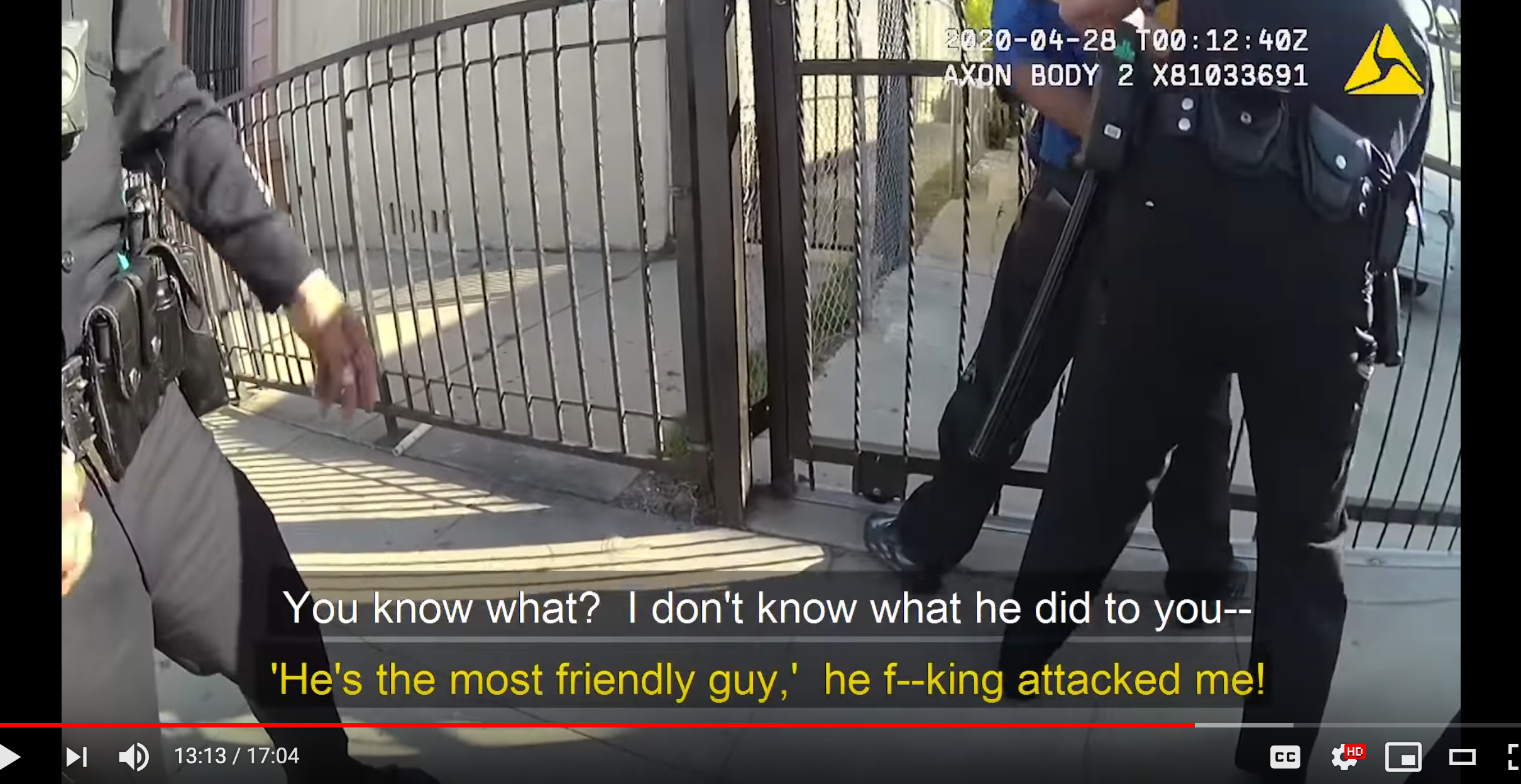
And then...the video cuts out.
Whatever conversation the cameras captured between the officers regarding the incident is not shown.
Neither is how the officers reacted to the bystanders who raised concerns about the beating or the one who produced cellphone footage of the violent incident.
Nor is whatever Castillo is told about why he is being arrested or why he will spend a night in jail and then be released the next day with no pending charges.
Given the extent to which the LAPD and departments across the country like to claim these kinds of incidents are the product of "bad apples" - not institutionalized culture or biases - that footage should be released so we can have, as Chief Moore says, “the whole story.”
Because although Moore had gone as far as to describe the incident as “disturbing,” the May 4 statement the LAPD quietly put out as bystander video began circulating on social media indicated LAPD planned to take no responsibility in this case.
Instead, they had aggressively downplayed both the brutality of the incident and Hernández’ role it.
Rather than acknowledge the number of times Hernández goaded, insulted, swore at, or chest-thumped his way through his interaction with Castillo prior to the assault, for example, the statement validated Hernández' actions by categorizing them as an "investigation."
Similarly, Hernández’ pummeling of Castillo was labeled a "physical altercation [that] occurred between the suspect and one of the officers" - a framing that suggested both parties had actively participated in some sort of bonafide scuffle and that left the door open for Hernández to be the hero who subdued a danger to society. The use of "receiving" in reference to Hernández - "resulting in the officer receiving minor injuries to his hand" - positioned the officer as the one being victimized by Castillo's face as he punched it.
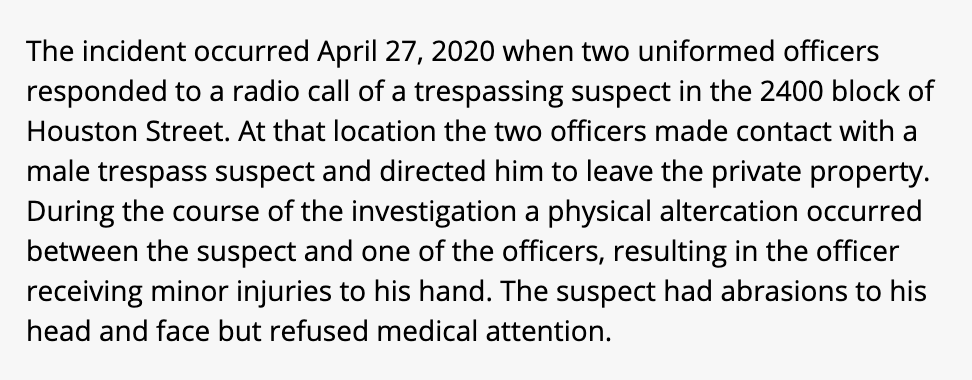
In contrast, Castillo was described as having been injured via immaculate conception: “The suspect had abrasions to his head and face.”
Then, on May 11, the day before the body cam footage was released, LAPD - with a huge assist from NBC4's investigative team - made clear that it was not letting one of its officers go down without a fight.
In a story titled, "Object Found at Scene of Violent Boyle Heights Police Confrontation Could Be Evidence," NBC4 reported LAPD investigators were looking at a "key piece of evidence" - an object that appeared to fall to the ground (or may have already been on the ground) while Castillo was being beaten.
The report replayed part of the assault in slow motion, zeroing in on a small black object seen skittering across the ground (screengrab below; click to visit the video) as Castillo moves to avoid the blows.
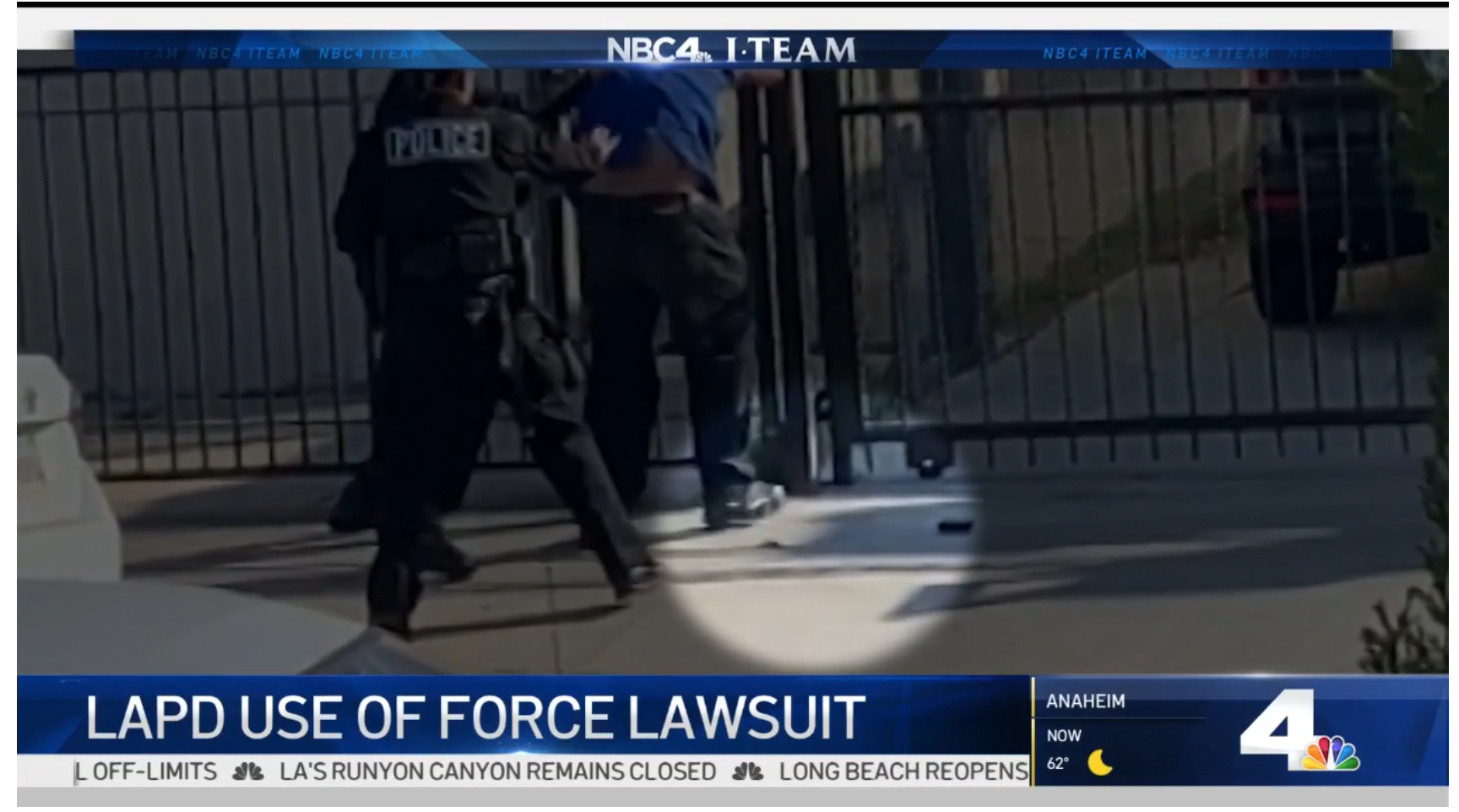
In the accompanying story, reporter Eric Leonard wrote that “multiple law enforcement sources with knowledge of the case” told NBC4 that what “appeared to be a large screw with a rubber or plastic grip, similar to improvised weapons sometimes found in jails and prisons” had been booked into evidence. [Emphasis added.]
Still taking cues from both law enforcement and Hernández' lawyer, Leonard then continued to paint Castillo as the aggressor. He repeated the lawyer's claim that Castillo had threatened Hernández just before the officer began throwing punches. And he made special note of how “one source who had viewed the police video said [Castillo] defied officers' directions and appeared to take a fighting stance before the eyewitness video begins.”
_______
A history of uses of force and cover-ups
Hernández, of course, had never mentioned a weapon during his attack on Castillo. He had instead loudly declared that Castillo’s hands had been free enough to grab his own.
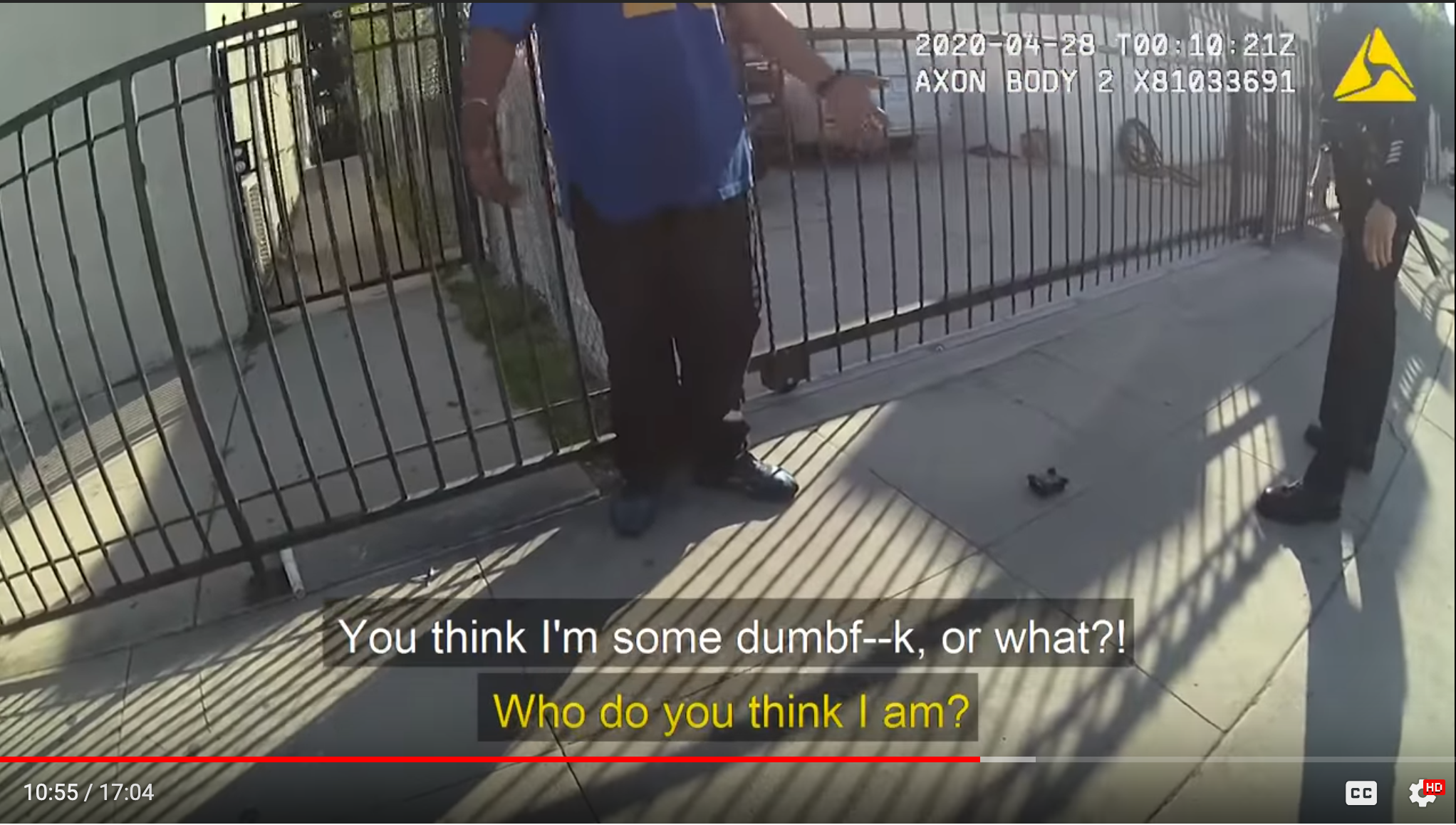
The emptiness of Castillo’s hands is also apparent at multiple occasions throughout the video (seen above), including at the moment that Hernández goes to cuff him - just seconds before the assault begins (below).
The one thing Castillo did have near his hands - his watch (seen on his left wrist) - is torn off his arm and thrown to the ground in a dramatic sweeping gesture by Hernández starting around minute 11:37 in the LAPD video.
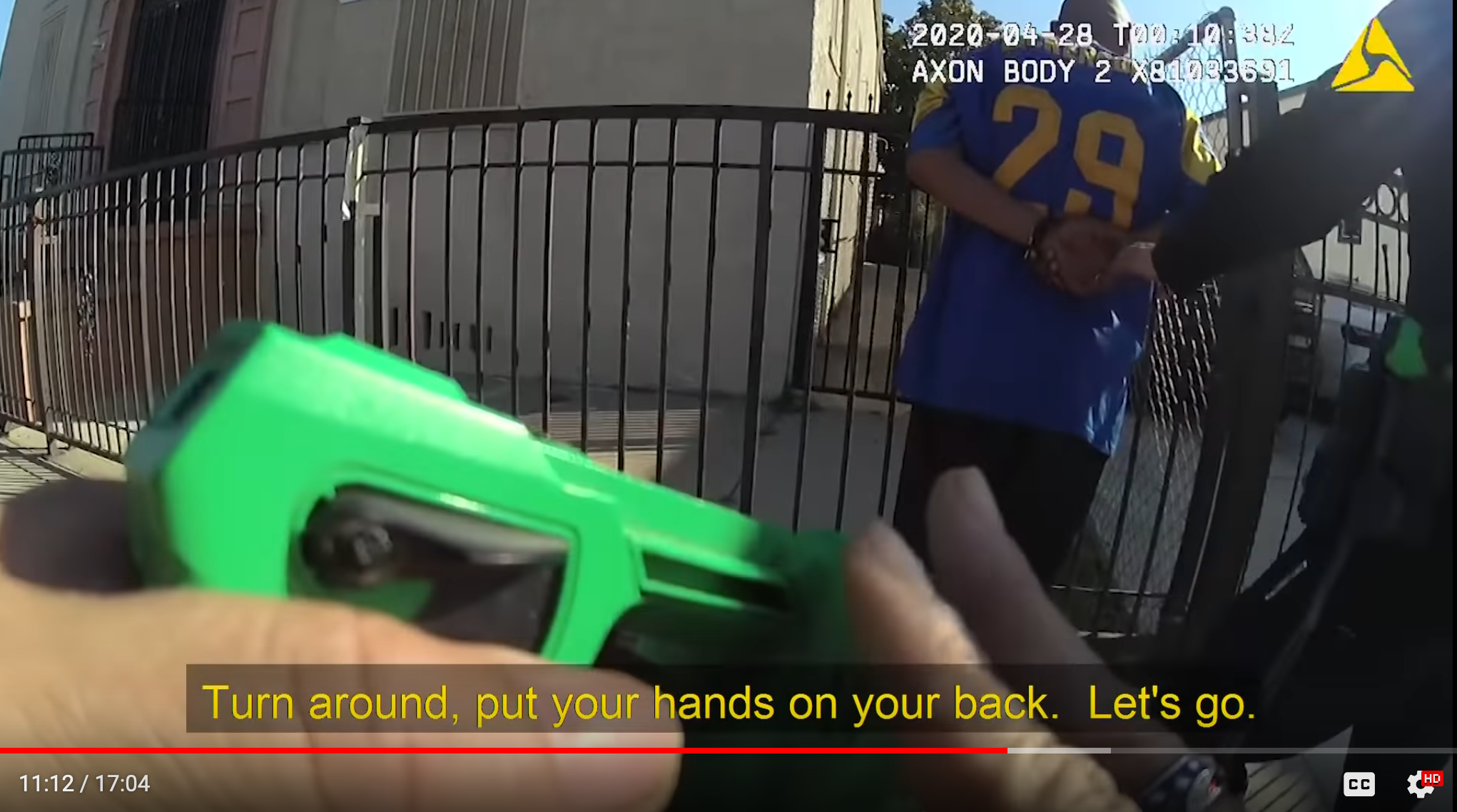
Hernández’ lawyer, David Winslow, never mentioned a weapon either.
Instead, he told the L.A. Times on May 5 that the threat Castillo posed was his physicality and his noncompliance. From the Times' story:
Winslow argued that prior to the footage that has been widely shared, the suspect was aggressive toward the police when they asked if he would consent to a search. During the initial search, the suspect allegedly struck the officer in the chest, knocking his body-worn camera to the ground, Winslow said. [...] “The use of force is justified because the officer believed he was under attack from the suspect … even though you might think the suspect wasn’t fighting back at that time, he wasn’t complying either,” Winslow said. “He didn’t go to the ground. He didn’t say ‘I give up.’”
This kind of dissembling is nothing new to either Hernández or the LAPD, however.
As reported by Richard Winton and James Queally for the Times, Hernández has tried to cover up questionable uses of force in the past.
After shooting an innocent teen in the back of the leg as he walked into his Angelino Heights home back in 2008, Hernández claimed the youth had run away from and then pointed a gun directly at officers. The LAPD statement released at the time supported that account, even though it would later be revealed that the only guns found on the scene were plastic, tucked away in a drawer upstairs, and had never been in the teen's hands.
Then, just two years later, Hernández shot and killed Guatemalan native Manuel Jamines Xum within 40 and 60 seconds of encountering him. Jamines had been inebriated and, as a K'che speaker, may not have understood Spanish or English commands to drop the knife he was alleged to have been carrying. Again, Hernández' account of the shooting differs significantly from those of other witnesses on the scene (seen here), including his claims regarding a woman and child in immediate danger (a pair other witnesses did not recall seeing), a woman having been grabbed by Jamines (the woman denied Jamines had a hold on her), and Jamines asking Hernández to kill him (something no one else heard).
Though the tactics used in the teen's shooting warranted “administrative disapproval,” that shooting, the killing of Jamines, and a non-fatal shooting of a female robbery suspect in 1999 were all found to be "in policy." For its part, the police union offered full-throated support for Hernández in 2010, decrying detractors who pointed at his history and arguing that if people didn't want to get shot, they needed to obey officer commands.
_______
Reimagining public safety requires reckoning with the depth of the rot
"Nobody hates a bad cop more than a good cop," said mayor Garcetti, speaking in reference to his proposed reforms this past June 4. "We have to make sure there is no culture of silence, there is no culture of acquiescence. That there is no culture of being a bystander. There is only right or wrong on our streets and on streets across America."
But getting from here to there is more complicated than stringing together a few purposeful but ultimately meaningless platitudes.
It is difficult to know whether Hernández would have faced any charges if not for the national spotlight on policing in the wake of the murder of George Floyd. Or whether the complaints made by bystanders would have triggered an internal investigation, had one of the neighbors not recorded the incident. Hernández clearly felt he could be violent with Castillo in front of his partner, and even ask her to tase him just for the hell of it. And he had no qualms about launching himself at Castillo in full view of area neighbors in broad daylight. Even when speaking to reporters on June 11 after entering his "not guilty" plea, Hernández maintained he had feared for his safety, been in "imminent danger," and "acted appropriately."
And if there's truly nothing LAPD hates more than a bad cop, then it's hard to square the department's effort to color public perception around the case via their official statement or the "evidence" of Castillo's aggression that was fed to NBC4. Those steps suggest they still default to protecting their own and remain resistant to any kind of introspection.
Regardless, for public safety to truly be "reimagined," any assessment undertaken must go beyond the most obvious abuses of authority and recognize that the rot not only extends beyond the apple, it extends beyond the tree.
The way Hernández escalated his encounter with Castillo at every turn, for example, mirrors the kind of disrespect, antagonism, and needless escalation that so many Black and brown people, men and youth in particular (and especially the unhoused), cite as hallmarks of the way they are engaged by LAPD. Those subjected to that kind of escalation know that every question they ask is seen as a challenge to authority and that every move they make is interpreted as a form of noncompliance or a threat - all of which puts them at increased risk of physical harm. And it is all too often how they find themselves pulled into the system via punitive quality-of-life infractions and bogus citations, falsified field interview cards and gang database entries, or arrests for contempt of cop.
For residents of over-policed communities like South Central, these encounters are disruptive, exhausting, stressful, trauma-inducing, and life-threatening. Moreover, the failure of law enforcement to serve as a resource for the community has long factored into youths' decisions to seek security in other ways - namely, gangs (see here, here, here, here, here, here). The persistent presence of gangs, in turn, has been used by both the city and LAPD to justify the need for an aggressive and oppressive police presence.
Over the years, the license given to LAPD in the name of "crime suppression" has encouraged massive sweeps, the battering down of people's doors and homes, the criminalization of disenfranchisement, the criminalization of houselessness, rampant racial profiling, and overt corruption (seen most recently in the "elite" Metro division). All of which has come at an immeasurable cost to L.A.'s Black community, even as it reassured whiter, wealthier communities that something was being done about "crime."
For these and so many other reasons, the larger conversation around defunding LAPD that BLM-L.A. opened in its presentation to the budget finance committee on June 15 must be heeded.
The time for tinkering around the edges has long since passed. Let the radical reimagining begin.
_______
This article has been focused on making the case for why limited reform is not enough. A number of coalitions have stepped forward to offer substantive alternative visions for L.A., all with an eye to mitigating the need for enforcement while righting the wrongs that left Black and brown communities behind. Please see Black Lives Matter's demands for Black L.A., the People's Budget (which members of BLMLA present in the video above), the work of the PUSH L.A. Coalition, Youth Justice Coalition's work centering juvenile justice, and the proposals of the Healthy L.A. Coalition to learn more.
Related stories
For more on the history of policing in L.A., see this deep dive into the history of South Central via the life of Nipsey Hussle:
The impact of trauma:
- Death and All His Friends Cast Long Shadows when they Make Regular Appearances in the Public Space
- What Does the “Failure” of the Ban on Fast-Food Restaurants in South L.A. to Curb Obesity Really Tell Us?
How violence in a community shapes youth behavior
- “Invest in Us!” say South L.A. Youth in Response to Questions about How to Curb Violence at Town Hall with Garcetti
- It’s a Small World: How Gang Activity Impacts the Livability of Streets (part 1); Are You Ready to Rumble?: Street Fights Take More Violent Turns (part 2); Listening to the Streets in Order to Make Them More Livable: Part III in a Series (part 3)
- To Be or Not to Be a Gang-Banger: Is that Really the Question?
- South Central Youth Assess Stasis and Change 25 years after the 1992 Unrest
Racial Profiling
- A Tale of Two Communities: New Security Measures at USC Intensify Profiling of Lower-Income Youth of Color (part 1); A Tale of Two Communities, Part II: LAPD Finds it Stirred Up Hornets’ Nest by Profiling USC Students of Color (part 2)
- Gardena PD Ticket, Harass United Riders of South Los Angeles for Taking Lane while the Case of the Hit-and-Run Victim They Were Honoring Remains Unsolved
- “You Don’t Belong Here:” Sheriffs Profile Reporter
- Are You Supposed to be Here?: Officer Harasses Black Cyclists during MLK Day Parade
- Filed Under: Ugly Things You Find on the Interwebs (an FB page claiming black people steal bikes)
- Days of Dialogue Opens Conversation on Police-Community Relations in South L.A., Gets an Earful
- Family of Man Crushed by Train During Altercation with Police over Fare Seeks Answers, Justice
- Handcuffing of Cyclist by USC Public Safety Raises Questions about Tactics, Oversight, Accountability
- USC's Public Safety Officers Tackle, Traumatize Woman for Hugging Tree on Sorority's Lawn
Incorporating these issues into planning processes
- Webinar on Policing and Mobility Underscores Struggle of Urban Planning to Center Justice (2018)
- Equity 101: Bikes v. Bodies on Bikes (2016)
- Man is Shot and Killed by the Officers He Called to Help Search for Stolen Bike. Is it a Livable Streets Issue? (2015)
- Election Reflections: “Law-and-Order,” the Resilience of White Supremacy, and You (2016)
- A Case for the Incorporation of Questions of Access Into Planning for Complete Streets (2013)
